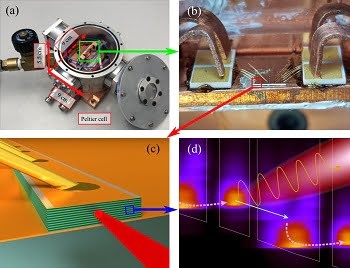ZÜRICH, Aug. 5, 2019 — Researchers at ETH Zurich have reported the highest operating temperature of a quantum cascade laser, which eliminates a major barrier in the practical implementation of the technology.
While not quite T-shirt temperature, the team from the Jérôme Faist group at the Institute for Quantum Electronics have reported an operational temperature of 210 K (−63° C), which is high enough to eliminate the need for cryogenic coolants. Instead, the team utilized a thermoelectric cooler, which is much more compact, less expensive, and easier to maintain than cryogenic equipment.
The team used a design that has long been known to allow for higher temperatures, but has been relatively difficult to achieve due to the intense level of precision required. The design stacks the simplest structure possible — two quantum wells per period — but is extremely sensitive to minute changes in the geometry of the semiconductor structures. Optimizing performance relative to one parameter can lead to degradation relative to another.

(a) The thermoelectrically cooled laser box with the laser mounted on top of a Peltier element (white square), allowing operation between 195 K and 210.5 K with the laser emitting vertically through the window in the top lid. (b) The laser chip as mounted in the laser box, contacted with thin gold wires bonded on top of several laser ridges. (c) Schematic of one laser ridge; the horizontal lines show the quantum-well structure formed by layered semiconductors. The ridge (150 µm wide) is sandwiched between thin layers of copper. (d) Conduction band edge (white lines) tilted by the applied operation bias, with the electron density resolved in energy shown in color. The electrical bias drives electrons through the nonradiative transitions indicated by the dashed arrow. This pumps the state in the thin well, which becomes more populated than the state in the wider well indicated by the green arrow, allowing for net stimulated emission of terahertz photons. Courtesy of Faist Group, ETH Zurich.

Previously, the highest temperature had been 200 K (−73° C), which still required the use of cryogenic coolants — traditionally liquid helium — which added a significant level of complexity, as well as substantial cost to operation.
The group remains optimistic about attempts to raise the temperature further.
The research was published in Applied Physics Letters (https://doi.org/10.1063/1.5110305).